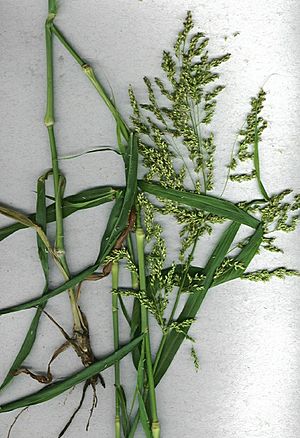Panicum antidotale facts for kids
Quick facts for kids Panicum antidotale |
|
|---|---|
 |
|
| Scientific classification | |
| Genus: |
Panicum
|
| Species: |
antidotale
|
| Synonyms | |
|
|
Panicum antidotale is a type of tall, woody grass. It's often called blue panicgrass in English or ghamur (ਘਮੂਰ) in Punjabi. This grass can grow up to 3 meters (about 10 feet) tall! You can find it growing across the Himalayas, in the Upper Gangetic Plain, and especially in parts of India (like Punjab) and Pakistan (like the Punjab province). This plant has strong roots that spread out underground, called rhizomes.
Long ago, a person named William Coldstream wrote about this grass. He noted that some people called it ghirri (ਘਿੱਰੀ). However, he found that many landowners thought ghirri was just a young, unripe form of Panicum antidotale, which they usually called ghamur.
Contents
Where Blue Panicgrass Lives
Panicum antidotale likes to grow in rich soils. These soils are often made better with compost or animal waste, whether they are sandy or clay-like. Interestingly, this grass is sometimes found growing close to caper bushes.
What Blue Panicgrass is Used For
This grass isn't very useful once it gets old because it starts to taste bitter. However, when it's young and tender, it can be used as forage (food) for animals. In the southwestern United States, people grow it for this purpose. Now, you can even find it growing wild there, as it was brought over from other places.
Pests and Diseases
Blue panicgrass can get a sickness called yellow stripe disease. This disease is also common in sugar-cane plants. The virus that causes this disease can stay in the grass for a long time. This means that even if sick sugar-cane plants are removed, the infected blue panicgrass nearby can still spread the disease to new, healthy sugar-cane plants.
Names in Different Languages
This grass has different names depending on where you are!
Punjabi Names
In different parts of Punjab, people have various names for this grass:
- In Firozpur, it's called garham (ਗਰ੍ਮ).
- In Hisar, it's known as ghirri (ਘਿੱਰੀ).
- In Jhang, it's called ghamūr (ਘਮੂਰ). Interestingly, it doesn't grow well in the salty soils (called kallar) of this area.
- In Multan, some people call it kuṭkī (ਕੁਟਕੀ).
Other Indian Languages
Names Around the World

